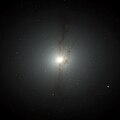NGC 4589
| Galaxie NGC 4589 | |
|---|---|
 | |
| AladinLite | |
| Sternbild | Drache |
| Position Äquinoktium: J2000.0, Epoche: J2000.0 | |
| Rektaszension | 12h 37m 24,988s [1] |
| Deklination | +74° 11′ 30,92″ [1] |
| Erscheinungsbild | |
| Morphologischer Typ | E2 / LINER[1] |
| Helligkeit (visuell) | 10,7 mag[2] |
| Helligkeit (B-Band) | 11,7 mag[2] |
| Winkelausdehnung | 3,4' × 2,8'[2] |
| Positionswinkel | 75°[2] |
| Flächenhelligkeit | 13,0 mag/arcmin²[2] |
| Physikalische Daten | |
| Zugehörigkeit | NGC 4291-Gruppe NGC 4386-Gruppe NGC 4589-Gruppe LGG 284[1][3] |
| Rotverschiebung | 0.006605 ± 0.000047[1] |
| Radialgeschwindigkeit | (1980 ± 14) km/s[1] |
| Hubbledistanz H0 = 73 km/(s • Mpc) | (95 ± 7) · 106 Lj (29,1 ± 2,0) Mpc [1] |
| Geschichte | |
| Entdeckung | Wilhelm Herschel |
| Entdeckungsdatum | 22. November 1797 |
| Katalogbezeichnungen | |
| NGC 4589 • UGC 7797 • PGC 42139 • CGCG 335-017 • MCG +12-12-013 • IRAS F12353+7428 • 2MASX J12372503+7411307 • GC 3127 • H I 273 • h 1374 • GALEXASC J123724.86+741130.2 • LDCE 902 NED009 | |
NGC 4589 ist eine elliptische Galaxie mit aktivem Galaxienkern vom Hubble-Typ E2 im Sternbild Draco am Nordsternhimmel. Sie ist schätzungsweise 95 Millionen Lichtjahre von der Milchstraße entfernt und hat einen Durchmesser von etwa 90.000 Lichtjahren. Gemeinsam mit NGC 4572 bildet sie ein (optisches) Galaxienpaar.
Die Typ-Ib-Supernova SN 2005cz wurde hier beobachtet.[4]
- (c) ESA/Hubble, CC BY 4.0
Das Objekt wurde am 22. November 1797 von Wilhelm Herschel entdeckt.[5]
NGC 4589-Gruppe (LGG 284)
| Galaxie | Alternativname | Entfernung/Mio. Lj |
|---|---|---|
| NGC 3901 | PGC 36386 | 82 |
| NGC 4127 | PGC 38550 | 88 |
| NGC 4159 | PGC 38777 | 84 |
| NGC 4291 | PGC 39791 | 85 |
| NGC 4319 | PGC 39981 | 72 |
| NGC 4331 | PGC 40085 | 77 |
| NGC 4386 | PGC 40378 | 81 |
| NGC 4589 | PGC 42139 | 95 |
| PGC 37864 | UGC 6996 | 95 |
| PGC 38347 | UGC 7086 | 96 |
| PGC 42601 | UGC 7872 | 90 |
Weblinks
Einzelnachweise
Auf dieser Seite verwendete Medien
(c) ESA/Hubble, CC BY 4.0
These Hubble Space Telescope images show elliptical galaxies with dark, wispy dust lanes, the signature of a recent galaxy merger. The dust is the only relic of a smaller galaxy that was consumed by the larger elliptical galaxy.
The "X" in the images marks the location of supernova explosions that are associated with the galaxies. Each supernova may have been gravitationally kicked out of its host galaxy by a pair of central supermassive black holes. When two galaxies merge, so do their supermassive black holes. Astronomers suggest the supernovae were stars that were once part of double-star systems. These systems wandered too close to the binary black holes, which ejected them from their galaxies. Eventually, the stars in each system moved close enough together to trigger a supernova blast.
These outcast supernovae are located at various distances from their home galaxies. SN 2000ds (left) is at least 12,000 light-years from its galaxy, NGC 2768; SN 2005cz (right) is at least 7,000 light-years from its galaxy, NGC 4589. NGC 2768 resides 75 million light-years from Earth, and NGC 4589 is 108 million light-years away.
The supernovae are part of a census of 13 supernovae to determine why they detonated outside the cozy confines of galaxies. The study is based on archived images made by several telescopes, including Hubble.
Both galaxies were observed by Hubble's Advanced Camera for Surveys. The image of NGC 4589 was taken on Nov. 11, 2006, and the image of NGC 2768 on May 31, 2002.Autor/Urheber: Meli thev, Lizenz: CC BY-SA 4.0
NGC 4589 with Hubble
Image Credit: NASA/ESA Hubble Space Telescope
Instrument: ACS
Filters: F435W, F555W, F814W
PI: Stephen Smartt
proposal id: 10498
link proposal: https://archive.stsci.edu/proposal_search.php?mission=hst&id=10498Autor/Urheber: Donald Pelletier, Lizenz: CC BY-SA 4.0
Image created using the Aladin Sky Atlas software from the Strasbourg Astronomical Data Center and
Pan-STARRS ([https://panstarrs.stsci.edu/ Panoramic Survey Telescope And Rapid Response System)
public data.



